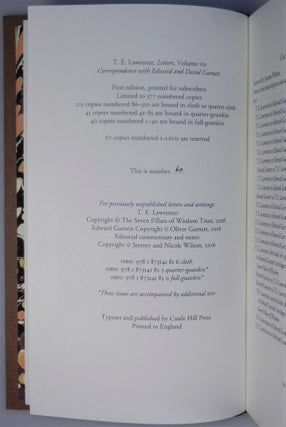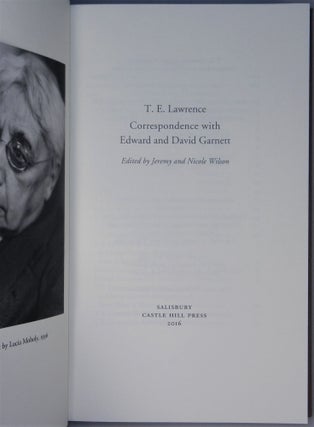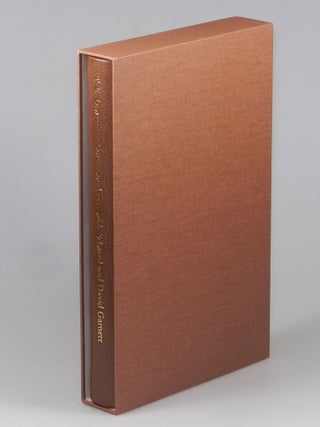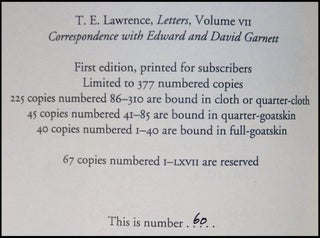T. E. Lawrence's Correspondence with Edward and David Garnett, the quarter goatskin binding of the limited edition, one of 45 issued thus
Salisbury: Castle Hill Press, 2016. First and limited edition. Quarter leather. This is the publisher’s quarter goatskin limited edition of T. E. Lawrence's Correspondence with Edward and David Garnett, an important installment in the T. E. Lawrence Letters series published by Castle Hill Press, the premier editors and fine press publishers of material by and about T. E. Lawrence. The edition is limited to a total of 377 numbered copies, of which 45 (copies #41-85) were beautifully bound thus for subscribers, in quarter brown goatskin with gilt spine print over brown cloth boards with double blind rule transition, top edge gilt, head and tail bands, and marbled endpapers. Featuring a frontispiece, and an index, the volume is housed in the publisher's felt-lined brown cloth slipcase. The publisher’s 45 quarter goatskin copies are also unique in content, these (along with the 40 full goatskin copies) featuring a 14-page supplement which contains the surviving (unerased) marginal annotations by Edward Garnett on the Oxford Times proof of Seven Pillars of Wisdom.
This copy is hand-numbered “60” on the limitation page and the Editor’s Foreword is hand-signed. This is an as-new copy, acquired by us from the publisher, pristine in every respect.
T. E. Lawrence (1888-1935) achieved fame from his remarkable odyssey as instigator, organizer, hero, and tragic figure of the Arab revolt against the Ottoman Empire during the First World War, which he began as an eccentric junior intelligence officer and ended as “Lawrence of Arabia.” But Lawrence’s literary and intellectual reach far exceeded the world and words of Seven Pillars of Wisdom. To the point, Lawrence’s friend Winston Churchill said: “Lawrence had a full measure of the versatility of genius… a savant as well as a soldier…. an archaeologist as well as a man of action… an accomplished scholar as well as an Arab partisan… a mechanic as well as a philosopher. His background of somber experience and reflection only seemed to set forth more brightly the charm and gaiety of his companionship, and the generous majesty of his nature.” (Great Contemporaries, p. 166)
This volume charts and reveals Lawrence’s literary ambitions, as well as his engaging facility as a correspondent. From the publisher: “Garnett, at the time one of the most influential figures in the British literary world, was the first critic to read Seven Pillars. He became Lawrence's literary mentor and they remained friends for the rest of Lawrence's life. From 1928 Edward Garnett's son David, a noted novelist, also corresponded with Lawrence. Both father and son constantly urged Lawrence to continue writing. David Garnett would later edit the first major collection of Lawrence's letters… Correspondence with Edward and David Garnett … contains many important letters that set out Lawrence's writing ambitions and self-criticisms, while others reveal how much he had studied and practised the craft of writing.
Some of the correspondence has been published or partially published in general collections, but all the letters gain considerably from being presented in the context of the entire surviving correspondence, accompanied by scholarly notes. The volume documents, among other things, the history of Garnett's 1922 abridgement of the 'Oxford' Seven Pillars which, at Bernard Shaw's behest, Lawrence decided not to publish… The correspondence also proves beyond any possible doubt that it was not until Lawrence accepted the subscription scheme for the 1926 edition of Seven Pillars that he decided to make no money, personally, from the book. If fame corresponded to achievement, Edward Garnett would be a famous name in English literature for the help he gave to aspiring writers such as D. H. Lawrence, Joseph Conrad, and others. But he was by nature a 'back-room boy'. He avoided fame, refusing the offer of public honours that he richly deserved. Lawrence, however, had no doubt how deeply he was in Garnett's debt. In gratitude he gave Garnett the manuscript of his second book, The Mint.”. Item #004105
Price: $850.00







